By Leen Randell
Updated: Jul 04, 2024
10 Best Herbal Decoctions For Chapped Lips
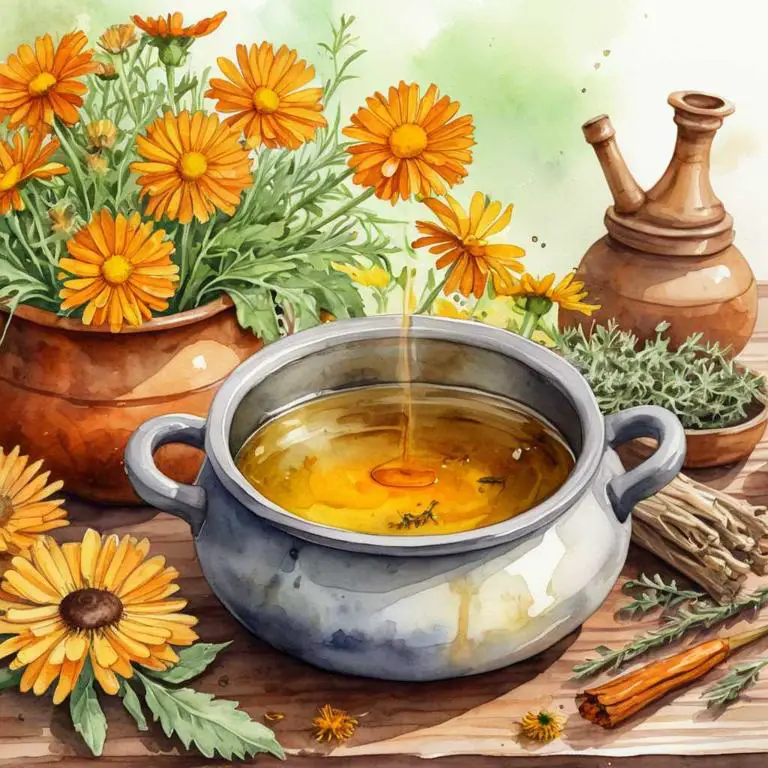
Herbal decoctions for chapped lips are natural remedies made by steeping herbs in hot water to create a soothing, topical treatment for dry, chapped lips.
These decoctions help to moisturize and calm irritated skin, providing relief from discomfort and pain. Examples of herbal decoctions that can be used to treat chapped lips include peppermint, chamomile, and calendula, which can be applied topically or consumed as a warm tea to promote healing and relaxation.
By using these natural remedies, individuals can enjoy healthy, soft lips that are free from irritation, improving their overall quality of life and confidence in their appearance.
The following article describes in detail the most important decoctions for chapped lips, including medicinal properties, parts of herbs to use, and recipes for preparations.
- 1. Calendula officinalis
- 2. Matricaria chamomilla
- 3. Glycyrrhiza glabra
- 4. Helianthus annuus
- 5. Hypericum perforatum
- 6. Lavandula angustifolia
- 7. Melaleuca alternifolia
- 8. Melissa officinalis
- 9. Mentha x piperita
- 10. Panax quinquefolius
- What is the best combination of herbal decoctions to use for chapped lips?
- What ailments similar to chapped lips are treated with herbal decoctions?
1. Calendula officinalis
Pot marigold decoctions helps with chapped lips because of its extraordinary anti-inflammatory and emollient properties.
The flavonoids and antioxidants present in pot marigold soothe and calm irritated skin, reducing redness and swelling caused by dry and cracked lips. Additionally, the natural oils and waxes in the decoction create a protective barrier on the skin's surface, locking in moisture and preventing further dryness.
This results in soft, smooth, and hydrated lips that are less prone to chapping and discomfort.

Medicinal Constituents
The list below shows the primary medicinal constituents in Calendula officinalis decoctions that help with chapped lips.
- Carotenoids: These pigments, particularly beta-carotene, have antioxidant properties that help protect the skin from damage, promoting healing and soothing of chapped lips.
- Flavonoids: As potent antioxidants, flavonoids help reduce inflammation and improve skin health, which can help alleviate chapped and dry lips.
- Triterpenoid saponins: These compounds have anti-inflammatory and moisturizing properties, which can help lock in moisture and soothe dry, chapped lips.
Parts Used
The list below shows the primary parts of pot marigold used to make decoctions for chapped lips.
- Flowers: They are used due to their high content of carotenoids and flavonoids, which have anti-inflammatory and soothing properties.
- Leaves: They are used because they contain compounds that help to protect and moisturize the skin, reducing dryness and chapping.
- Roots: They are used because they have a higher concentration of saponins, which can help to soothe and heal chapped skin.
Quick Recipe
The following recipe gives a procedure to make a basic pot marigold for chapped lips.
- Harvest fresh calendula officinalis flowers in the morning after the dew has evaporated when they are at peak potency.
- Clean the flowers thoroughly by gently rinsing them with filtered water to prevent contamination.
- Combine 1 tablespoon of dried flowers with 1 cup of boiling water to create the decoction.
- Steep the mixture for 10 to 15 minutes to allow the active compounds to infuse into the water.
- Strain the decoction using a cheesecloth or fine-mesh sieve to remove the plant material.
2. Matricaria chamomilla
Chamomile decoctions helps with chapped lips because of its soothing and anti-inflammatory properties.
The apigenin present in chamomile has a calming effect on the skin, reducing redness and irritation caused by dry and chapped lips. The decoction also moisturizes the lips, providing relief from dryness and discomfort.
As a result, chamomile decoctions help to heal and protect chapped lips, leaving them soft, smooth, and hydrated.

Medicinal Constituents
The list below shows the primary medicinal constituents in Matricaria chamomilla decoctions that help with chapped lips.
- Apigenin: A flavonoid compound that helps soothe and calm irritated skin, reducing inflammation and discomfort associated with chapped lips.
- Matricaria chamomilla oil: Terpene alcohols that have anti-inflammatory and moisturizing properties, helping to hydrate and protect dry, chapped lips.
- Apigenin-7-o-glucoside: A flavonoid glycoside that contributes to the soothing and anti-inflammatory effects of Matricaria chamomilla, also helping to reduce irritation and discomfort associated with chapped lips.
Parts Used
The list below shows the primary parts of chamomile used to make decoctions for chapped lips.
- Flowers: Used to make decoctions for chapped lips because of their anti-inflammatory and soothing properties.
- Leaves: Used to make decoctions for chapped lips because of their antiseptic and moisturizing properties that help to heal and protect the skin.
- Roots: Used to make decoctions for chapped lips because of their anti-inflammatory and antioxidant properties that help to soothe and nourish the skin.
Quick Recipe
The following recipe gives a procedure to make a basic chamomile for chapped lips.
- Harvest matricaria chamomilla flowers when in full bloom and dry them completely in a well-ventilated area.
- Measure out 20-30 grams of dried flowers for every 250 milliliters of water to be used.
- Combine the measured dried flowers with the water in a saucepan and gently heat the mixture over low heat.
- Steep the mixture for 5-7 minutes to allow the flowers to infuse their active compounds into the water.
- Strain the decoction through a cheesecloth or a fine-mesh sieve into a cup or bottle to remove the solids.
3. Glycyrrhiza glabra
Licorice decoctions helps with chapped lips because of its potent anti-inflammatory and moisturizing properties.
The compounds found in licorice root, such as glycyrrhizin and flavonoids, soothe and calm dry, irritated skin, providing instant relief to chapped lips. When consumed as a tea or used topically as a lip balm, licorice decoctions help lock in moisture, reducing flakiness and promoting healthy lip cell regeneration.
This natural remedy is an effective way to combat dry, chapped lips without harsh chemicals or artificial additives.

Medicinal Constituents
The list below shows the primary medicinal constituents in Glycyrrhiza glabra decoctions that help with chapped lips.
- Licorice glycosides: These compounds help with chapped lips by providing anti-inflammatory and soothing properties, which reduce redness and irritation, promoting the healing of dry, cracked skin.
- Flavonoids: These phenolic compounds possess antioxidant and anti-inflammatory properties, which help protect the skin from damage, reducing inflammation and promoting the repair of damaged skin cells.
- Saponins: These triterpenoid saponins have anti-inflammatory and moisturizing properties, which help to soothe and hydrate dry, chapped skin, reducing the discomfort and pain associated with chapped lips.
Parts Used
The list below shows the primary parts of licorice used to make decoctions for chapped lips.
- Roots: They contain glycyrrhizin, a sweet-tasting compound with anti-inflammatory and soothing properties that help to heal chapped lips.
- Leaves: They are rich in glycosides, flavonoids, and other compounds that provide antioxidant, anti-inflammatory, and moisturizing effects to relieve chapped lips.
- Barks: They contain a mixture of saponins, flavonoids, and terpenoids that help to soothe and protect chapped lips, while also promoting wound healing.
Quick Recipe
The following recipe gives a procedure to make a basic licorice for chapped lips.
- Gather 2-3 grams of dried glycyrrhiza glabra roots and ensure they are free from contaminants.
- Boil 500ml of water in a saucepan over medium heat for 5 minutes to prepare the decoction base.
- Add the dried glycyrrhiza glabra roots to the boiling water and reduce the heat to low.
- Simmer the mixture for 10-15 minutes to allow the active compounds to infuse into the water.
- Strain the decoction through a fine-mesh sieve into a cup or glass bottle for consumption.
4. Helianthus annuus
Sunflower decoctions helps with chapped lips because of its incredible moisturizing properties.
The antioxidants and fatty acids present in sunflowers help to lock in moisture, providing long-lasting relief from dryness and discomfort. As a natural emollient, it soothes and softens the lips, reducing inflammation and flakiness. Additionally, sunflower decoctions can help to repair damaged lip tissue, promoting healthy cell growth and a smooth, supple appearance.
With regular use, chapped lips become a thing of the past, replaced by hydrated, luscious lips that feel wonderful!.
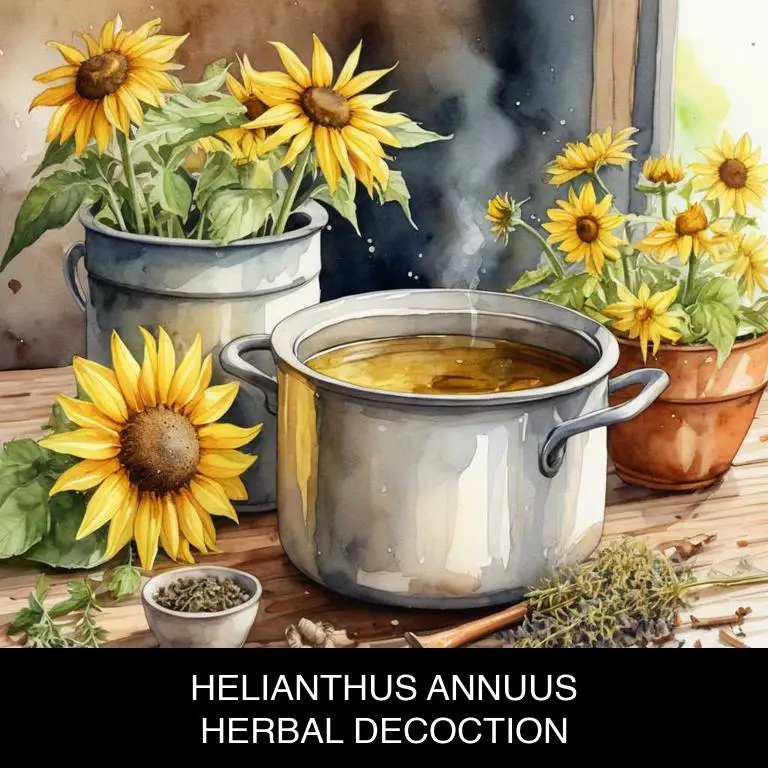
Medicinal Constituents
The list below shows the primary medicinal constituents in Helianthus annuus decoctions that help with chapped lips.
- Phenolic acids: They help with chapped lips by providing antioxidant properties that protect the skin from damage, reduce inflammation, and promote wound healing.
- Flavonoids: They help with chapped lips by acting as natural moisturizers, improving skin hydration, and reducing the appearance of fine lines and wrinkles.
- Squalene: It helps with chapped lips by acting as an emollient, locking in moisture, and protecting the skin from water loss, thus providing relief from dry and chapped skin.
Parts Used
The list below shows the primary parts of sunflower used to make decoctions for chapped lips.
- Seeds: The seeds are used to make decoctions for chapped lips due to their high content of fatty acids and antioxidants that help moisturize and protect the skin.
- Leaves: The leaves are used to make decoctions for chapped lips because they contain flavonoids and other compounds that have anti-inflammatory and soothing properties.
- Flowers: The flowers are used to make decoctions for chapped lips due to their high content of vitamins and minerals, particularly vitamin E and iron, that help nourish and protect the skin.
Quick Recipe
The following recipe gives a procedure to make a basic sunflower for chapped lips.
- Harvest fresh helianthus annuus flowers when they are in full bloom and the petals have fully opened.
- Dry the flowers in a well-ventilated area for 2-3 days to reduce moisture content.
- Combine 20 grams of dried helianthus annuus flowers with 1 liter of water in a saucepan.
- Simmer the mixture over low heat for 10-15 minutes to release the active compounds.
- Strain the decoction through a cheesecloth or fine-mesh sieve into a clean container.
5. Hypericum perforatum
St John's wort decoctions helps with chapped lips because of its natural anti-inflammatory and soothing properties.
The decoction, made by steeping dried St John's Wort flowers in hot water, releases flavonoids and hypericin compounds that penetrate the skin and provide relief from dryness and irritation. As a result, it helps to calm and moisturize chapped lips, reducing redness and discomfort.
Additionally, its antimicrobial properties may help to prevent infections caused by cracked or irritated skin, promoting overall lip health and comfort.

Medicinal Constituents
The list below shows the primary medicinal constituents in Hypericum perforatum decoctions that help with chapped lips.
- Hyperforin: Acts as a potent antioxidant and anti-inflammatory agent, which helps to soothe and protect chapped lips from further irritation and damage.
- Naphthodianthrones: Exhibits antimicrobial properties, inhibiting the growth of bacteria and fungi that can exacerbate chapped lip conditions and promote healing.
- Quercetin: A flavonoid with anti-inflammatory and antioxidant properties, which helps to reduce inflammation, promote collagen synthesis, and enhance skin hydration, ultimately improving the health and appearance of chapped lips.
Parts Used
The list below shows the primary parts of st john's wort used to make decoctions for chapped lips.
- Leaves: They contain flavonoids and phenolic acids that provide antioxidant and anti-inflammatory properties to soothe chapped lips.
- Flowers: Rich in flavonoids and anthocyanins, they help to protect and moisturize the skin on chapped lips.
- Stems: The stems contain hyperforin, a compound that can help to soothe and protect the skin on chapped lips.
Quick Recipe
The following recipe gives a procedure to make a basic st john's wort for chapped lips.
- Harvest 20-30 grams of fresh st john's wort flowers and leaves from a sunny location on a dry morning.
- Dry the harvested material in a single layer at 50 degrees celsius for 2-3 hours in a low-temperature oven.
- Grind 2-3 teaspoons of dried st john's wort flowers and leaves into a fine powder using a coffee grinder.
- Combine the powdered st john's wort with 500 milliliters of boiling water in a saucepan and simmer for 5-7 minutes.
- Strain the decoction through a cheesecloth or a fine-mesh sieve into a cup and discard the solids.
6. Lavandula angustifolia
English lavender decoctions helps with chapped lips because of its soothing and moisturizing properties.
The antiseptic and anti-inflammatory compounds present in lavender oil calm irritated skin, reducing redness and swelling associated with dry, cracked lips. Additionally, the decoction's emollient effects help to lock in moisture, providing long-lasting relief from discomfort and dryness.
As a result, English lavender decoctions provide a natural and effective solution for softening and soothing chapped lips.
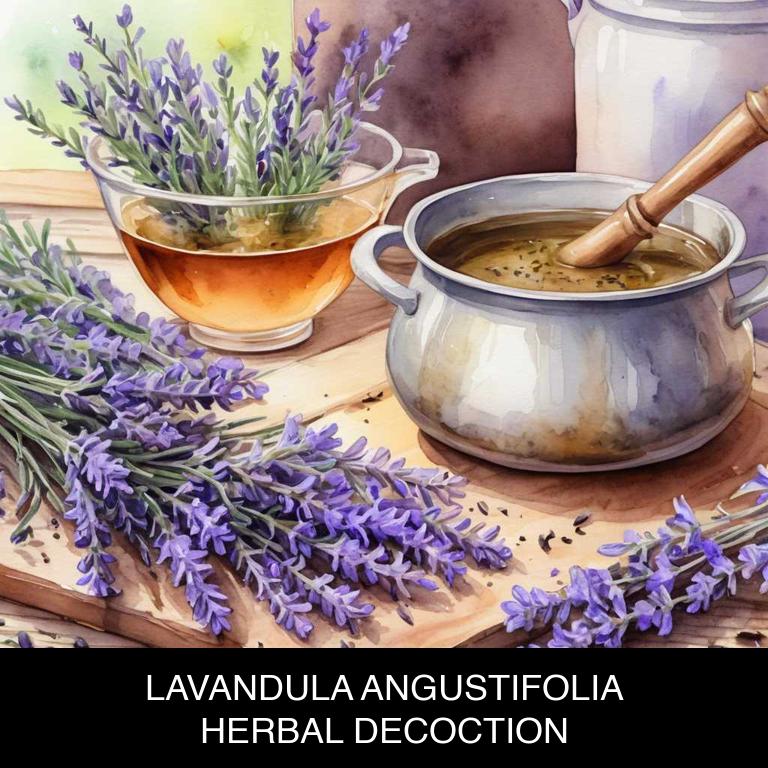
Medicinal Constituents
The list below shows the primary medicinal constituents in Lavandula angustifolia decoctions that help with chapped lips.
- Linalool: A terpene that acts as an antimicrobial agent, helping to reduce infection and inflammation that can exacerbate chapped lips.
- Linalyl acetate: A terpene with analgesic and anti-inflammatory properties, which can help soothe and calm irritated skin on the lips.
- Rosmarinic acid: A phenolic compound with antioxidant and anti-inflammatory effects, which can help protect the skin from environmental stressors and promote healing of dry, chapped lips.
Parts Used
The list below shows the primary parts of english lavender used to make decoctions for chapped lips.
- Flowers: They are used due to their soothing and moisturizing properties, which help to calm and hydrate dry, chapped lips.
- Leaves: They are used because they contain antiseptic and anti-inflammatory compounds that help to protect and soothe chapped lips.
- Stems: They are used due to their ability to provide a gentle exfoliating effect, helping to remove dead skin cells and promote healthy lip tissue.
Quick Recipe
The following recipe gives a procedure to make a basic english lavender for chapped lips.
- Harvest fresh lavandula angustifolia flowers in the morning when they are dry and free from dew.
- Clean the harvested flowers by gently brushing off any dirt or debris from the delicate petals.
- Measure out 2 grams of dried lavandula angustifolia flowers for every 100 milliliters of boiling water.
- Steep the dried flowers in boiling water for 5 to 10 minutes to allow the active compounds to infuse.
- Strain the decoction through a cheesecloth or a fine-mesh sieve into a clean container to remove the solids.
7. Melaleuca alternifolia
Tea tree decoctions helps with chapped lips because they possess natural antibacterial and anti-inflammatory properties that soothe and calm dry, cracked skin.
The antioxidants present in these decoctions help to reduce lip irritation and promote healing, leaving lips feeling soft, smooth, and hydrated.
Additionally, the astringent properties of tea tree decoctions help to tighten up the skin's pores, reducing the appearance of fine lines and wrinkles around the mouth area, giving the lips a more youthful and radiant appearance.
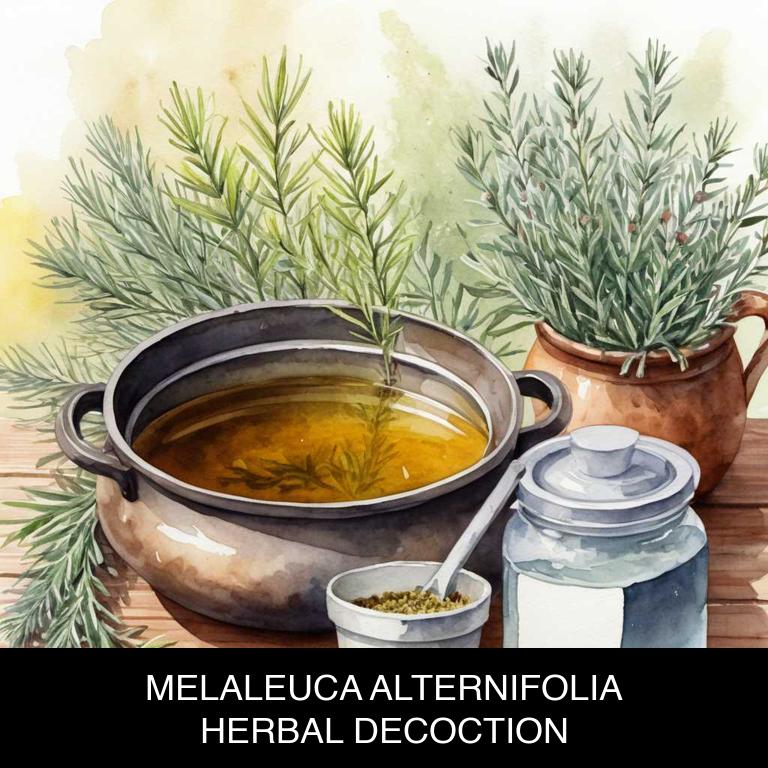
Medicinal Constituents
The list below shows the primary medicinal constituents in Melaleuca alternifolia decoctions that help with chapped lips.
- Cineole: This terpene helps to soothe and protect chapped lips by reducing inflammation and providing a barrier against environmental factors.
- Methyl eugenol: This phenolic compound exhibits antimicrobial properties, which can help prevent infections and promote wound healing, making it beneficial for treating chapped lips.
- Caryophyllene: This sesquiterpene has anti-inflammatory properties, which can help reduce redness, swelling, and discomfort associated with chapped lips, promoting a faster recovery.
Parts Used
The list below shows the primary parts of tea tree used to make decoctions for chapped lips.
- Leaves: Their essential oils help soothe and moisturize dry, chapped lips.
- Buds: They contain antimicrobial properties that aid in healing and protecting the lips.
- Leaves: They are also a rich source of antioxidants that help to protect and repair damaged skin.
Quick Recipe
The following recipe gives a procedure to make a basic tea tree for chapped lips.
- Harvest 20-30 fresh leaves of melaleuca alternifolia in the early morning or late afternoon when the plant is at its highest concentration.
- Dry the harvested leaves in a cool dry place for 7-10 days or until they become brittle and crumbly.
- Measure out 1 teaspoon of dried leaves for every 250ml of water and add them to a pot.
- Bring the water to a boil then reduce heat to a simmer and let the mixture steep for 5-10 minutes.
- Strain the decoction through a cheesecloth or a fine-mesh sieve into a cup and discard the solids.
8. Melissa officinalis
Lemon balm decoctions helps with chapped lips because of its natural anti-inflammatory properties that soothe dry, irritated skin.
The decoction's antioxidant-rich compounds, such as rosmarinic acid and flavonoids, help to calm inflammation and reduce redness. Additionally, lemon balm's astringent properties draw out excess moisture and impurities from the lip surface, leaving lips feeling soft, smooth, and hydrated.
Regular use of lemon balm decoctions can provide long-lasting relief from chapped lips, promoting healthy, radiant-looking lips.
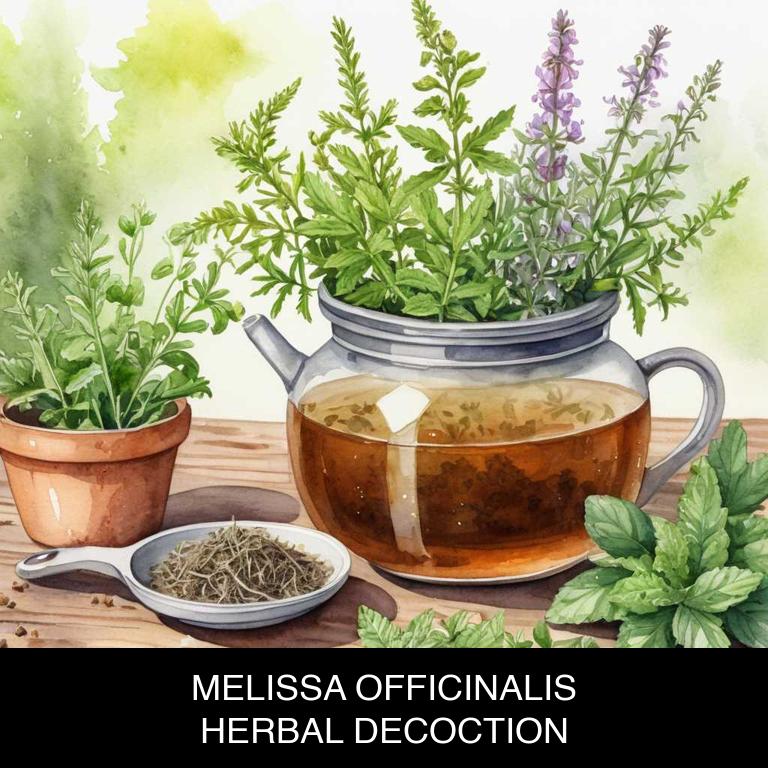
Medicinal Constituents
The list below shows the primary medicinal constituents in Melissa officinalis decoctions that help with chapped lips.
- Rosmarinic acid: This phenolic compound helps with chapped lips by exhibiting antioxidant and anti-inflammatory properties, which soothe and calm irritated skin, reducing the appearance of dry, chapped lips.
- Linalool: As a terpene, linalool has antiseptic and anti-inflammatory effects, which help protect and calm chapped lips by reducing inflammation and promoting healing.
- Volatile oils: These terpenes help with chapped lips by providing moisturizing and soothing effects, which can help lock in moisture and calm dry, chapped skin.
Parts Used
The list below shows the primary parts of lemon balm used to make decoctions for chapped lips.
- Leaves: Known for their soothing and anti-inflammatory properties, which can help to calm and moisturize chapped lips.
- Stems: Contain antiseptic properties that can help to heal and protect chapped lips from infections and dryness.
- Roots: Possess anti-inflammatory and antioxidant properties, which can aid in soothing and repairing damaged skin on chapped lips.
Quick Recipe
The following recipe gives a procedure to make a basic lemon balm for chapped lips.
- Harvest melissa officinalis leaves in the morning after the dew has evaporated with a sharp knife.
- Clean the harvested leaves thoroughly to remove dirt and debris under cold running water.
- Combine 1 tablespoon of melissa officinalis leaves with 1 cup of boiling water in a heat-resistant cup.
- Steep the mixture for 5 to 10 minutes to allow the herbal properties to infuse into the water.
- Strain the decoction through a fine-mesh sieve into a cup to remove the melissa officinalis leaves.
9. Mentha x piperita
Peppermint decoctions helps with chapped lips because of its unique blend of antioxidants, anti-inflammatory compounds, and soothing properties.
The decoction's cooling effect instantly relieves dryness and discomfort, while its antioxidants work to repair damaged lip tissue. The menthol content also helps to lock in moisture, leaving lips soft, smooth, and hydrated. Additionally, peppermint's natural antibacterial properties help to prevent the growth of bacteria that can contribute to chapping.
Overall, a warm cup of herbal peppermint decoction is a simple yet effective way to soothe and nourish dry, chapped lips.

Medicinal Constituents
The list below shows the primary medicinal constituents in Mentha x piperita decoctions that help with chapped lips.
- Menthol: It helps with chapped lips by providing a protective barrier and reducing inflammation due to its cooling and anesthetic properties.
- Menthone: It contributes to soothing and moisturizing chapped lips by its ability to reduce inflammation and promote skin hydration.
- Rosmarinic acid: It aids in alleviating chapped lips by exerting antioxidant and anti-inflammatory effects, which help to protect the skin from further irritation and promote healing.
Parts Used
The list below shows the primary parts of peppermint used to make decoctions for chapped lips.
- Leaves: They are commonly used due to their high menthol content, which provides a cooling and soothing effect on chapped lips.
- Stems: Stems are often used as they contain a high amount of menthone, a compound that helps to moisturize and protect dry, chapped lips.
- Roots: Roots of Mentha x piperita are sometimes used due to their peppermint oil content, which can help to calm and soothe irritated skin on chapped lips.
Quick Recipe
The following recipe gives a procedure to make a basic peppermint for chapped lips.
- Gather 20-30 grams of fresh or 10-15 grams of dried menthaxpiperita leaves for decoction.
- Combine gathered menthaxpiperita with 1 liter of boiling water in a heat-resistant container.
- Steep the mixture for 10-15 minutes or until the liquid has reduced slightly in volume.
- Strain the decoction through a cheesecloth or a fine-mesh sieve into a separate container.
- Allow the decoction to cool to room temperature before consuming it as needed.
10. Panax quinquefolius
American ginseng decoctions helps with chapped lips because of its remarkable anti-inflammatory properties, which soothe and calm irritated lip tissues.
The decoction's hydrating effects also help to lock in moisture, leaving lips feeling soft and supple. Additionally, American ginseng's natural antioxidants neutralize free radicals that can cause lip dryness and brittleness, promoting healthy lip function and appearance.
As a result, using an herbal American ginseng decoction as a lip treatment can provide long-lasting relief from chapped and dry lips.
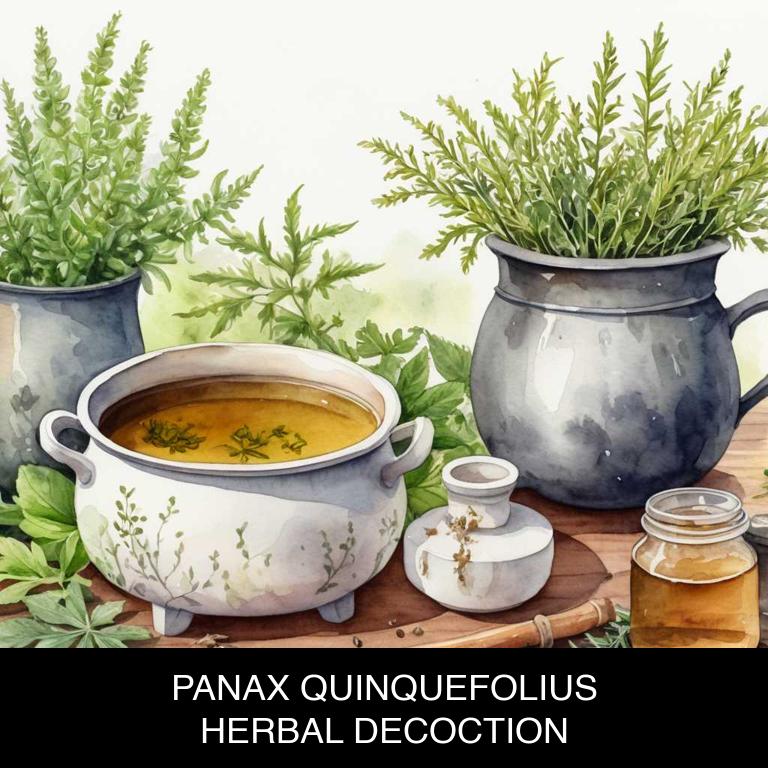
Medicinal Constituents
The list below shows the primary medicinal constituents in Panax quinquefolius decoctions that help with chapped lips.
- Ginsenosides: These triterpenoid saponins help with chapped lips by promoting collagen synthesis and improving skin elasticity, reducing the appearance of fine lines and wrinkles.
- Polyphenols: These antioxidant compounds help with chapped lips by neutralizing free radicals, reducing inflammation, and protecting the skin from environmental stressors, ultimately promoting healthy skin cell growth.
- Flavonoids: These plant-based compounds help with chapped lips by improving blood flow and oxygenation to the skin, which can help to nourish and hydrate dry, chapped lips, promoting a healthier and more resilient lip environment.
Parts Used
The list below shows the primary parts of american ginseng used to make decoctions for chapped lips.
- Roots: Rich in saponins, which help to moisturize and protect dry, chapped lips.
- Leaves: Contain antiseptic and anti-inflammatory properties, which aid in soothing and healing chapped lips.
- Barks: Rich in antioxidants and flavonoids, which help to protect and hydrate dry, chapped lips.
Quick Recipe
The following recipe gives a procedure to make a basic american ginseng for chapped lips.
- Gather 1-2 ounces of dried panax quinquefolius root and 2 cups of water for the decoction.
- Bring the water to a boil in a pot and add the dried panax quinquefolius root.
- Reduce the heat to a simmer and let the mixture steep for 30-60 minutes.
- Strain the decoction through a cheesecloth or fine mesh to remove the root residue.
- Store the decoction in a glass container and refrigerate for up to 3 days.
What is the best combination of herbal decoctions to use for chapped lips?
The best combination of herbal decoctions that help with chapped lips is a blend of aloe vera, chamomile, and calendula.
Aloe vera provides soothing and moisturizing properties, while chamomile calms and reduces inflammation. Calendula, rich in antioxidants, promotes wound healing and skin regeneration.
To make this decoction, steep 1 tablespoon of dried aloe vera, 1 tablespoon of dried chamomile, and 1 tablespoon of dried calendula in boiling water for 5-7 minutes, then strain and apply as a balm or lip scrub for nourished and healthy lips.
What ailments similar to chapped lips are treated with herbal decoctions?
Ailments similar to chapped lips that are treated with herbal decoctions are dry and cracked skin, eczema, and dermatitis.
Decoctions made from herbs such as aloe vera, chamomile, and calendula can help soothe and moisturize the skin, reducing inflammation and promoting healing.
These decoctions can be used topically or taken internally to address underlying issues contributing to these conditions.